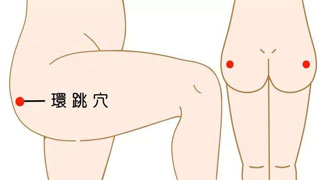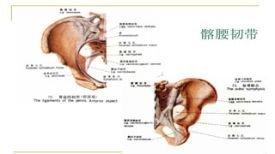
Whether it's talking about the gluteus maximus, gluteus maximus, piriformis muscle in the buttocks, or the fascia, sciatic nerve, adductor muscles, and upper and lower gluteus maximus, we cannot avoid the well-known acupoint "the upper can treat the waist, the lower can treat the feet", which is our main point today, the Huan Tiao acupoint.
1、 Acupoint location
The "ring" in the name of the acupoint refers to a curved ring; Jump, jump.
In the eyes of ancient people, the function of Huantiao acupoint may be as follows: Huantiao acupoint is a meridian point of the Foot Shaoyang Gallbladder Meridian, located near the hip joint. Therefore, it is also known as hip bone, ring valley, hip aversion, hip pivot, central pivot, and central pivot.
Huan Tiao acupoint, located at the buttocks, is responsible for lower limb movements, referring to the bending of the lower limbs, hip flexion, and jumping in a circular motion. The heel can touch this acupoint, hence the name. At the same time, treatment through this acupoint can improve lower limb diseases and perform circular jumping exercises.
Huan Tiao, Huan, is a circular jade object or a section of a chain with a hole in the middle. This refers to the cool and humid qi characteristic of the heavenly lung metal in the material inside the acupoint. Jumping, jumping, the vitality of yang, the vitality of yang qi in the acupoints.
The name "Huan Tiao" refers to the large amount of water and dampness in the gallbladder that vaporizes into the Heavenly Yang Qi. The substance in this acupoint is the moisture from the earth that comes from the Ju Liao acupoint. After reaching this acupoint, the moisture seeps into the plump muscles inside and vaporizes into the yang energy of the sky. The strong yang energy inside the acupoint makes people feel like they are in the air, hence the name Huan Tiao.
Acupoint lateral positioning method: On the line connecting the protuberance point of the greater trochanter and the upper end of the buttock fissure, at the inner 2/3 and outer 1/3, that is, the upper back of the greater trochanter; Or as the center of the triangle between the greater trochanter, iliac crest, and ischial tuberosity.
Lying down method: Open about four inches next to the sacral fissure (i.e. waist Yu acupoint).
Supine positioning method: Move two horizontal fingers behind the upper edge of the greater trochanter.
2、 Indicative diseases
There are many annotations about the Huan Tiao acupoint in the literature:
Su Wen ": Wang's annotation: The meeting of the two meridians of Foot Shaoyang and Sun.
Jin Jian ": It is mainly used for treating pain caused by wind, cold, dampness, and muscle spasms in the arms, hips, thighs, and knees.
Acupuncture and moxibustion: It mainly focuses on cold rheumatism, inhumanity, rubella all over the body, hemiplegia, waist and crotch pain, stiff knees, and should not turn sideways.
The Classics A and B of acupuncture and moxibustion and Moxibustion: The waist and hypochondriac phases cause acute pain, the thigh muscles are tied to the shin, the humeral pain cannot be bent or extended, the arthralgia is not benevolent, and the ring jump is the main way.
Bronze Man: Treatment for cold wind, warm rheumatism, rubella, hemiplegia due to wind deviation, and inability to turn due to pain in the waist and hips.
According to the above literature, the indications for stimulating the Huan Tiao acupoint are as follows:
1. Sports system diseases: sciatica, lower limb paralysis, sequelae of cerebrovascular disease, lower back and leg pain, hip joint and surrounding soft tissue diseases, beriberi;
2. Other: Cold, neurasthenia, rubella, eczema.
The two most widely used clinical indications are lower back pain and lower limb lethargy
1. Pain in the waist and hips
Many patients describe the location of their lower back pain, but if they are asked to accurately circle and draw it, many of them are concentrated near the sacroiliac joint. Strictly speaking, it is no longer the "waist", but closer to the "buttocks".
There are a large number of tissues around the Huan Tiao acupoint, including skin, subcutaneous tissue, gluteal fascia, gluteus maximus, sciatic nerve, adductor muscle (tendon), and upper and lower gluteus maximus. The skin is doubly distributed by the lateral branch of the iliopsoas nerve and the gluteal epithelial nerve.
The subcutaneous fascia is well-developed, rich in fibers and adipose tissue, and there is thick and dense fat forming a fat pad in the lower back of the buttocks.
In the deep surface of the gluteus maximus, the sciatic nerve originates from the inferior foramen of the piriformis muscle above the adductor muscle in the pelvis. The surface location of this point is at the midpoint of the line connecting the posterior superior spine of the bone and the ischial tuberosity.
2. Lower limb lethargy
Before the sciatic nerve travels towards the back of the lower limbs, it needs to pass through the inferior foramen of the piriformis muscle. Therefore, if the tension of the piriformis muscle is abnormal, it is very easy to compress the sciatic nerve, causing symptoms of "lower limb paralysis".
The downward projection of the Huan Tiao acupoint is slightly inward of the midpoint of the line connecting the ischial tuberosity and the greater trochanter of the femur. On the inner side of the sciatic nerve, there are the posterior femoral cutaneous nerve, inferior gluteal nerve, blood vessels, as well as the pudendal nerve and blood vessels. Once the nerves are compressed, it is highly likely to cause lower limb fatigue.
The obturator tendon beneath the nerve and its upper and lower muscles are innervated by the muscular branches of the sacral plexus.
3、 Application of Huan Tiao acupoint
Huantiao point, together with other points, has different effects on acupuncture and moxibustion.
Paired with Yinmen, Yanglingquan, Weizhong, and Kunlun acupoints, it has the effects of unblocking meridians, promoting blood circulation, and relieving pain, and treating sciatica.
Located in Liaozhong, Weizhong, and Xuanzhong, it has the function of dispelling wind, removing heat, and dispersing cold, and is mainly used for treating wind cold dampness syndrome.
Paired with Fengchi acupoint and Quchi acupoint, it has the effect of dispelling wind, promoting blood circulation, and relieving itching. It is mainly used to treat rubella throughout the body.


